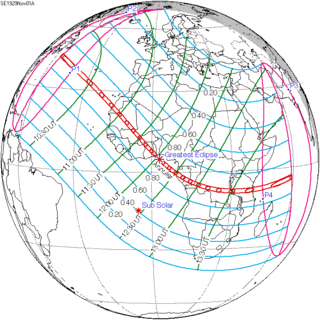An annular solar eclipse occurred on November 1, 1929. A solar eclipse occurs when the Moon passes between Earth and the Sun, thereby totally or partly obscuring the image of the Sun for a viewer on Earth. An annular solar eclipse occurs when the Moon's apparent diameter is smaller than the Sun's, blocking most of the Sun's light and causing the Sun to look like an annulus (ring). An annular eclipse appears as a partial eclipse over a region of the Earth thousands of kilometres wide. Annularity was visible from Spanish Sahara (today's West Sahara), French West Africa (parts now belonging to Mauritania, Mali, Burkina Faso, and southwestern tip of Benin), British Gold Coast (today's Ghana), French Togoland (today's Togo) including capital Lomé, Portuguese São Tomé and Príncipe (today's São Tomé and Príncipe), French Equatorial Africa (parts now belonging to Gabon and R. Congo) including capital Brazzaville, Belgian Congo (today's DR Congo) including capital Léopoldville, Northern Rhodesia (today's Zambia), British Tanganyika (now belonging to Tanzania) including capital Dar es Salaam, and British Seychelles (today's Seychelles) including capital Victoria.
YouTube Encyclopedic
-
1/5Views:894 2553 0262 23830 964559
-
Stories from the Great Depression
-
Total Solar Eclipse Timelapse 20th March 2015
-
UPSIDE DOWN (AUG 2017) Mandela Effect, Bible Changes
-
Larry Nichols' Plan to Save Trump
-
7 Facts about Idaho
Transcription
Related eclipses
Solar eclipses of 1928–1931
This eclipse is a member of a semester series. An eclipse in a semester series of solar eclipses repeats approximately every 177 days and 4 hours (a semester) at alternating nodes of the Moon's orbit.[1]
| Solar eclipse series sets from 1928 to 1931 | ||||
|---|---|---|---|---|
| Ascending node | Descending node | |||
| 117 | May 19, 1928 Total (non-central) |
122 | November 12, 1928 Partial | |
| 127 | May 9, 1929 Total |
132 | November 1, 1929 Annular | |
| 137 | April 28, 1930 Hybrid |
142 | October 21, 1930 Total | |
| 147 | April 18, 1931 Partial |
152 | October 11, 1931 Partial | |
Saros 132
This eclipse is a part of Saros cycle 132, repeating every 18 years, 11 days, containing 71 events. The series started with partial solar eclipse on August 13, 1208. It contains annular eclipses from March 17, 1569 through March 12, 2146, hybrid on March 23, 2164 and April 3, 2183 and total eclipses from April 14, 2200 through June 19, 2308. The series ends at member 71 as a partial eclipse on September 25, 2470. The longest duration of annular was 6 minutes, 56 seconds on May 9, 1641, and totality will be 2 minutes, 14 seconds on June 8, 2290. All eclipses in this series occurs at the Moon’s descending node.
| Series members 28–50 occur between 1690 and 2100: | ||
|---|---|---|
| 28 | 29 | 30 |
 June 11, 1695 |
 June 22, 1713 |
 July 4, 1731 |
| 31 | 32 | 33 |
 July 14, 1749 |
 July 25, 1767 |
 August 5, 1785 |
| 34 | 35 | 36 |
 August 17, 1803 |
 August 27, 1821 |
 September 7, 1839 |
| 37 | 38 | 39 |
 September 18, 1857 |
 September 29, 1875 |
 October 9, 1893 |
| 40 | 41 | 42 |
 October 22, 1911 |
 November 1, 1929 |
 November 12, 1947 |
| 43 | 44 | 45 |
 November 23, 1965 |
 December 4, 1983 |
 December 14, 2001 |
| 46 | 47 | 48 |
 December 26, 2019 |
 January 5, 2038 |
 January 16, 2056 |
| 49 | 50 | |
 January 27, 2074 |
 February 7, 2092 | |
Notes
- ^ van Gent, R.H. "Solar- and Lunar-Eclipse Predictions from Antiquity to the Present". A Catalogue of Eclipse Cycles. Utrecht University. Retrieved 6 October 2018.
References
- Earth visibility chart and eclipse statistics Eclipse Predictions by Fred Espenak, NASA/GSFC




